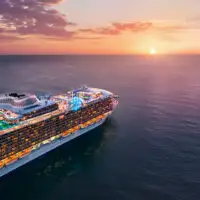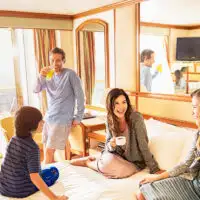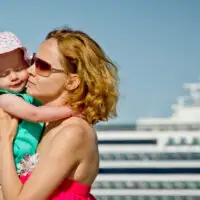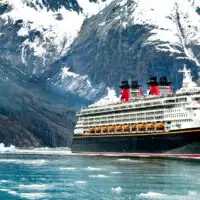Skepticism is high on the idea of “traveling with a purpose” or “voluntourism” aboard Carnival Fathom’s new social impact cruise to the Dominican Republic. But don’t let that stop you from booking what could actually be an impactful experience for your family.
Carnival’s Fathom also cruises to Cuba, and is the first cruise line to sail from the U.S. to Cuba in more than 50 years. The Cuban Fathom Cruise offers immersion experiences in the port cities of Havana, Cienfuegos and Santiago de Cuba.
We took the inaugural journey to the Dominican Republic and are here to say that while this cruise does force you out of your comfort zone, it is an experience like no other. It’s a way for you to bond with the family while educating your children (who must be at least 8 years old to sail) about life and different cultures. You will have fun — it’s not all about getting your hands dirty while volunteering and there is plenty of time for the pools — but by the end of the volunteer vacation, you’ll wonder who saw a greater impact on your trip — you or the people of the Dominican Republic.
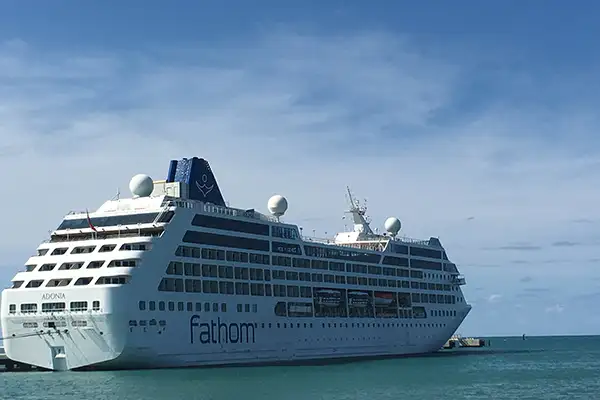 Ship Activities Onboard Adonia
Ship Activities Onboard Adonia
The Carnival Fathom cruise takes place aboard the Adonia. The small size of the Adonia ship is noticeable if you have cruised previously. While the Adonia is beautiful, it lacks in amenities for children. There is no kids’ club, skating rink, sports court or rock climbing wall, and the ship’s pool is small. However, the small size of the ship allows kids to make friends quickly. (Still, a meet-and-greet event would be helpful in making that connection faster.)
There are ship scavenger hunts, tons of board games, puzzles, books and cards in the library, evening movies, giant Jenga and Ping-Pong, but mostly kids “find” each other and make their own fun.
Making Friends
Travelers are encouraged to attend group seminars to learn more about what they will encounter in the Dominican Republic. The “Story of You,” “Learning Spanish Phrases,” and “Lifehack Bootcamp” are a few of the available seminars, hosted at various times and days and included in rates. You’re not mandated to attend them, but if you decide to go, participation is required. It’s the participation that brings this ship of strangers closer together in preparation for their time in the Dominican Republic.
If the seminars don’t interest you, chatting with someone new at dinner or by the pool will be your way of getting to know your shipmates.
Port of Call
The Dominican Republic Fathom cruise stops in one port, Amber Cove, an $85-million Carnival Corporation investment. Amber Cove offers families a delightfully huge pool (zero-entry and stairs) with multiple lifeguards, hundreds of lounge chairs (it would be hard NOT to find a chair), loungers in a pool, pool noodles, a splash pad for kids with a small slide, two larger waterslides, and Wi-Fi – all of which are included with your cruise rate. For an additional $8 per day, Wi-Fi access can be upgraded in Amber Cove.
For an additional cost, families can purchase unlimited runs on a zip-line that flies above the pool, hourly use of pedal boats, kayaks and paddleboards. Poolside or waterfront cabanas are also available to rent for the day. There are no shaded areas to find around the pool, but guests can rent an umbrella for $8. Restrooms and lockers are also easily accessible.
There is an indoor/outdoor restaurant (not included and cash or credit cards are needed) and poolside servers are happy to bring you lunch or a cocktail. Climb up to the Sky Bar and travelers will find a bar with breathtaking views (great spot for a photo op of the Adonia). Several shops (clothing, souvenirs, jewelry, liquor) and a coffee shop also fill the expansive port. Amber Cove mostly shuts down after dark, but guests can still enter and exit if they want to explore Puerto Plata.
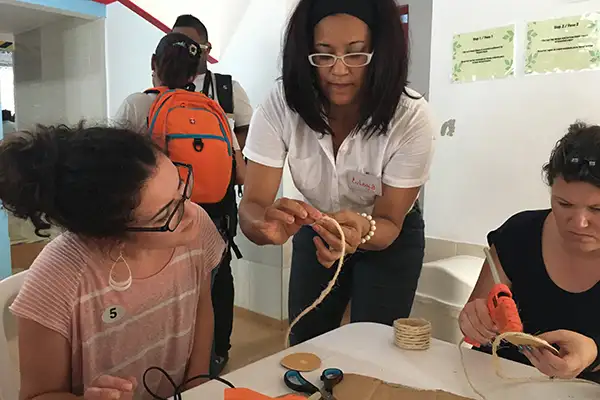 Voluntourism: Social Impact Activities
Voluntourism: Social Impact Activities
The first thing the guides tell you is that they want everyone to get out of their comfort zones. They want you to be uncomfortable (to a point) and by putting yourself out there and experiencing something different, it’s you who begins to change while slowly impacting change in Puerto Plata. The overall voluntourism or social impact goal is that once travelers arrive in Puerto Plata, they will engage, interact and work with the Dominican Republic people through the predetermined volunteer activities.
Travelers work alongside the Dominican Republic people and can choose from eight activities: Reforestation (planting trees); Recycled Paper (creating sheets of paper from paper bits); Cacao Women’s Chocolate Cooperative (creating chocolate molds and wrapping chocolate bars); Community English, Student English (teaching English to adults or children), Water Filters (using clay to construct a filter), Concrete Floors (pouring cement floors in homes) and Creative Arts, Music and Sports (playing with children in the summer months). A group of about 25 or 50 people (depending on the activity) will head to each activity at specified times.
Note: Fathom does not require anyone to do anything. Participation in the Social Impact Activities is entirely up to the individual.
The three pillars of the social impact volunteer activities — social, environment and economic — are easily built upon each week as new travelers arrive. It’s the connection that is made between local and traveler that is the most impactful for both cultures. While, yes, you may only spend a few hours with the Dominican chocolate entrepreneurs, the next day another group will wrap even more chocolate bars and the next week another group of travelers will arrive at the port to make even more chocolate. Week one students who speak zero English may have learned “hello, how are you?” and in week two, they could perhaps answer that question in English. Imagine if in a year’s time, those same students could hold a full conversation in English, all because of you!
Working with the children was the most rewarding for our trip. While we felt pressure to teach the fourth graders the entire English language in 20 minutes (despite not speaking Spanish ourselves), their wide eyes and big smiles quickly made us realize they were just as nervous and excited as us.
Each activity takes place in a different Puerto Plata community and it is interesting to see how different the communities can be. The Cacao Chocolate is made in the countryside while the students are taught in schools in more of a “city” atmosphere. Expect to see poverty, trash and debris line many of the streets and stray dogs everywhere. Travelers are asked not to touch them. Also, be weary of numerous moto taxis (motorcycle taxis) that zip around.
Logistics
Prior to your trip or onboard, travelers can schedule activities for the mornings or afternoons during the two half-days and two full-days in port. The volunteer activities can be physically or emotionally draining so we recommend spacing them out. Do a full day of volunteer programs and a day of pool time the next day or do a volunteer activity each morning and relax in the afternoons. The call time for morning activities is around 7:15 a.m. each morning (don’t expect to be sleeping in on this cruise), a delicious local lunch is provided and included in the cruise rate, and travelers return to Amber Cove by about 1 or 2 p.m. Afternoon volunteer activities leave around noon or 1 p.m. and return by about 5 p.m.
Shuttle bus transportation to each impact activity is included in the cruise rate and an Impact Guide, who is there to translate, take photos and help in any way, escorts you and participates in each activity with your group. Additional guides are often already at the activity destination to greet you and help as well. Unlimited bottled water is also provided. The guides often refer to the travelers as family and soon, you truly feel as though you are one giant, multicultural family.
Some impact activities are more physically taxing than others so be mindful of what your family is capable of when scheduling activities. You may get dirty planting trees or making a water filter out of clay. The recycled paper and chocolate activities involve more sitting. Wheelchairs can also be accommodated on several of the activities, as well. You do not need to speak Spanish in order to teach English. Having the ability to speak Spanish would obviously be helpful, but is by no means required. No experience is necessary to participate in any of the activities. The Dominican people show the travelers how to do each step of the activities and the Impact Guides are there to translate when necessary.
Genuine Experiences Equal Growth
Participating in the Social Impact Volunteer Activities as a family is not only a teachable moment, but also opens eyes up to parts of the world that may not be as fortunate as others. Puerto Plata has not seen a tourism economy in decades, so it’s not your typical tourist destination. For children and adults to see a country that has homes with dirt floors or no piped water, easily expands the horizons of those unfamiliar with poverty or developing countries.
For a family to see how little the Dominican people have in possessions but how rich they are in life, is also eye opening and allows families to feel empathy rather than sympathy. Where verbal communication lacks between the English and Spanish speaking, a connection or bond is still quick to form. To have a 10-year-old American teach a Dominican Republic fourth grader the English phrase of “I am happy,” eludes to so much more than a sentence.
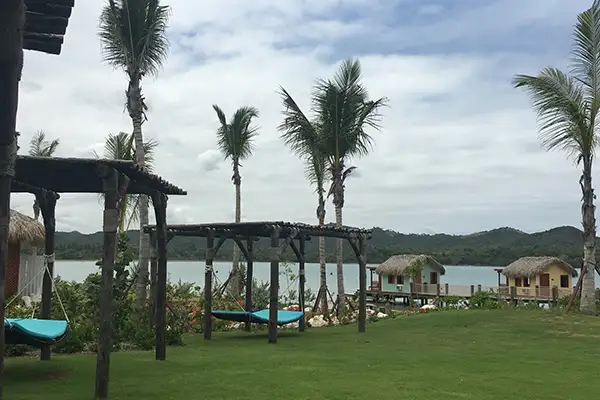 Non-Volunteer Shore Excursions
Non-Volunteer Shore Excursions
While there is a focus on social impact activities, shore excursions like snorkeling, deep sea fishing, zip-lining through the countryside or touring the island, beaches, or Fort San Felipe are also welcome ways to enjoy your time in Puerto Plata.
Shore excursions are an additional expense and you will need to secure a taxi to the excursion at your own cost. Taxis are readily available at Amber Cove and a cost list is posted for some of the different excursions. Note that there is room for negoatiations regarding the taxi fare.
Safety
Never once did we feel unsafe while outside of Amber Cove. There is sometimes a police presence with the travelers to help with traffic and maneuvering large buses through small streets, but we always felt safe. Impact Guides are always with you and when walking through the streets, everyone is waving hello. There is security to re-enter Amber Cove and the ship, as well, plus multiple checkpoints where guests must show their cruise/room card.
What to Pack
Dress for the entire cruise is casual. While people may dress up slightly for dinner in a sundress or slacks, there is no formal dinner night and shorts are welcome at the dinner table (bathing suits are not). Pack T-shirts, shorts, jeans, long pants, long skirts or dresses and sneakers or comfort shoes and flip flops. Heels are not needed. It’s also requested that if you plan to work with the children on your activities, knees and shoulders should be covered and no tight clothing is permitted. Sunblock and bug spray are also a must. A backpack is also a good idea.
It’s a bit of walk from where the bus drops you after a social impact activity back to the ship, so if you plan to hang out in Amber Cove after an activity, bring your bathing suit or other items with you on the activity.
Remember to bring cash (American dollar is accepted) to your social impact activities as there are opportunities to purchase chocolate that you just wrapped, a card that was created from recycled paper or other souvenir items.
More From Family Vacation Critic:
Adonia Family Cruise
Are Carnival Cruises From Close-to-Home Ports Worth It?
Royal Caribbean Anthem of the Seas for Families
Our team of parents and travel experts chooses each product and service we recommend. Anything you purchase through links on our site may earn us a commission.



